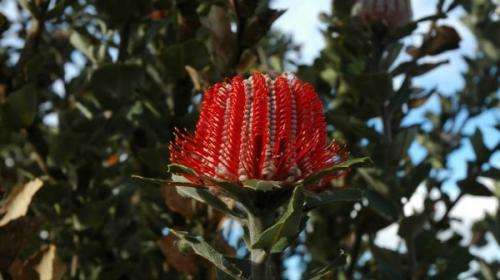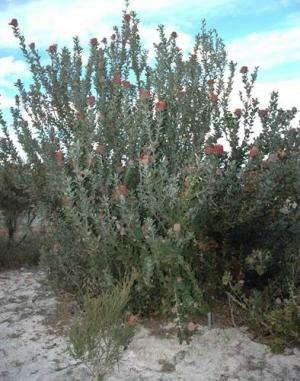Banksias differ on resilience to climate change

Research into the germination requirements of four Banksia species (Proteaceae) endemic to the South West Australian Floristic Region (SWAFR) has found certain species may be more vulnerable to climate change than others.
Australian National University scientist Anne Cochrane recently led the project, investigating drought tolerance during seed germination in B.baxteri, B.coccinea, B.media and B.quercifolia.
Seeds from the four Banksia species were collected from high-, medium- and low-rainfall natural populations in the SWAFR and subjected to a range of temperatures and moisture conditions.
They found optimal germination was a delicate balance between temperature and moisture levels for the four species, with some populations of species responding to certain conditions better than others.
"Obviously no moisture stress is optimal for germination," Dr Cochrane says.
They determined B.coccinea seeds were most vulnerable to drought stress with B.media seeds the least vulnerable.
The SWAFR has suffered a 20 per cent reduction in annual rainfall since the 1970s and predictions of increasing temperatures and further rainfall declines mean water availability is a major factor limiting germination in SWAFR ecosystems.
"Once seedlings emerge they need to get their roots down to water as soon as possible," Dr Cochrane says.
"If the soil dries out before seedlings have established...they can die."
There was no correlation between natural population rainfall levels and drought tolerance however, they found steep declines in germination in all species when the moisture potential was less than -0.25MPa, with 0MPa being saturated and -1.5MPa being wilting point

All four species had optimal germination at 15°C, reflecting the cool, wet winters of the SWAFR's Mediterranean climate
Increasing temperatures and decreasing rainfall may shorten this winter period however and limit the window of opportunity for germination as well as increase fire frequency.
Banksia species are particularly vulnerable to these changes as they rely solely on seeds for reproduction after the parent plant is burnt.
Dr Cochrane says the four species are relatively common but current threats like Phytophthora cinnamomi (dieback) in combination with climate change have the potential to cause rapid declines in the future.
"We do our best to have conservation measures in place...but these measures are not really going to have a rapid impact on a changing climate," she says.
"What we most need is for people's attitudes to change and for resourcing for conservation...to increase."
Provided by Science Network WA





















